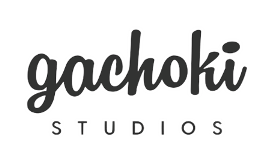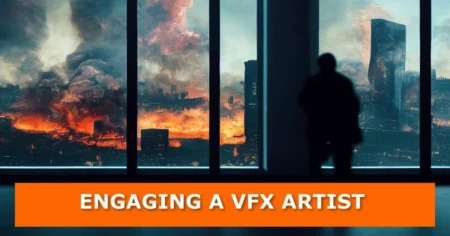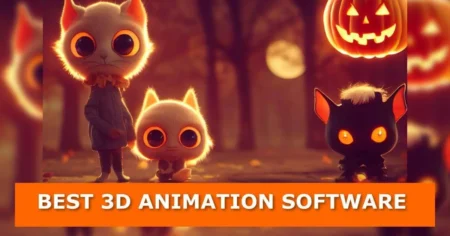1. What is Blender software?
Blender is an excellent open-source program known for its 3D animation and modeling capabilities.
It’s a powerful piece of software that’s been used in feature films, games, TV shows, and a variety of other incredible projects. Blender, however, is capable of much more. Video editing, compositing, painting, sculpting, visual effects, cloth simulation, particle simulation, fluid and smoke simulations, 3D printing, and, more recently, 2D animation and real-time rendering.
Blender is available for download for free at the official Blender website.
2. Best computer specifications to run Blender
| Minimum specs | Recommended specs | Optimal specs |
| 64-bit dual-core 2Ghz CPU with SSE2 support | 64-bit quad-core CPU | 64-bit eight-core CPU |
| 4 GB RAM | 16 GB RAM | 32 GB RAM |
| 1280 × 768 display | Full HD display | Full HD displays |
| Mouse, trackpad or pen+tablet | Three-button mouse or pen+tablet | Three-button mouse and pen+tablet |
| Graphics card with 1 GB RAM, OpenGL 3.3 | Graphics card with 4 GB RAM | Graphics card with +12 GB RAM |
Graphics cards (GPUs) that are compatible with Blender
Whenever you use a GPU to render in Blender, make sure to install the latest drivers from the graphics card manufacturer’s website. The following are GPU brands and model ranges that are compatible with Blender.
NVIDIA
GeForce 400 and newer, Quadro Tesla GPU architecture and newer, including RTX-based cards, with NVIDIA drivers
AMD
GCN 1st gen and newer. Since Blender 2.91, Terascale 2 architecture is fully deprecated, try using 2.90 (albeit not supported, it might still work)
Intel
Haswell architecture and newer.
macOS
Version 10.13 or newer for Intel processors on supported hardware. Version 11.0 for Arm-based processors (Apple Silicon).
3. Who uses Blender software?
Blender is an ideal program used by small animation companies, freelance 3D artists, independent filmmakers, students beginning to learn about 3D computer graphics, and dedicated computer graphics hobbyists.
4. Is Blender good for beginners?
Blender has a lot of tools and functions, but you usually get used to it after a few weeks. However, mastery of Blender will require a lot of practice. How fast you master Blender depends on your level of interest, commitment, and frequency of practice.
5. How and where you can learn to use Blender software
You can learn how to use Blender by enrolling in an online school or by teaching yourself using the numerous tutorials available online. Enroll in an online school if you can afford it. Don’t be discouraged if you can’t afford it. There are plenty of video tutorials available online that cover everything from the fundamentals to advanced topics. In addition, there is a large supportive community of experienced Blender users willing to assist you.
Online schools that teach how to use Blender
The following are websites where you can learn how to use Blender one-on-one. On the websites, you can get help from professional Blender tutors. It is up to you to pick the one that works best for you.
- Blender Cloud website
- CG Cookie website
- Several tutors on Udemy website
- Several tutors on SkillShare website
Where to get free tutorials that teach you how to use Blender
There are hundreds of excellent Blender YouTubers out there. Here is a handful that I am familiar with:
- Blender’s official YouTube channel
- Blender Secrets, for quick short tutorials
- Default Cube, for quick short tutorials
- CrossMind Studio, for product design and animation using Blender
- DECODED, for animation and VFX stuff
- Ian Hubert, for quick short tutorials
- InLightVFX, for in-depth tutorials
- Blender Guru, for in-depth tutorials
- PIXXO 3D, for in-depth tutorials
- CG Geek, for in-depth tutorials
- Many more YouTubers. Search for them on YouTube.
6. Awesome resources and assets for Blender
Documentation of the inner workings of Blender software
- Blender Manual. This is a written online Blender manual that is maintained largely by volunteers.
- Blender Wiki. Here you can find information about Blender’s development process, design and architecture, as well as instructions for Building Blender.
- Python API. Python API documentation for Blender
Free online courses
High school level course by James Chronister of Central Dauphin High School, Harrisburg, PA USA
Communities and forums
- Official Blender site user community page
- Blender Nation
- Blender Artists
- Blender Cloud
- Blender Discord OpenVFX
- Blender Stack Exchange: Here you can ask other Blender users for assistance on how to do anything using Blender
- Blender Artists Community The largest online forum for Blender 3D artists. Here you can post questions you may have about Blender.
- Blender Artists: A Facebook group where Blender users share their still renders and videos. A good place to get inspiration
- Blender: Another Facebook group where Blender users share their still renders and videos. A good place to get inspiration
- Blender Artists Community: Another Facebook group where Blender users share their still renders and videos. A good place to get inspiration
- Blender 3D: A Reddit subreddit where Blender users share their still renders and videos. A good place to get inspiration
Material asset libraries you can use with Blender
Addons repositories for Blender
- Official Addons Catalog
- Blender Addon List
- Community add-ons featured on Blendernation
- BlenderArtists
- Blender Market
- Gumroad
- CGDive’s Blender Addon Directory
Sound assets you can download and use in Blender
- Soundcloud has many free downloadable audio tracks, the terms of use mention optional Creative Commons, but these files seem to be rare.
- INCOMPTECH Creative Commons music
- CCMixter Creative Commons music
- Freesound Has a large collection of sound effects.
- FreeSFX has a medium(ish) collection of free sounds. (Registration required)
- sfxr Is a simple sound effect generator
- Bfxr Is is an elaboration of sfxr and has a web interface that allows the download of created effects.
- OpenGameArt.org: sound effects, music, and more. Various licenses.
Themes you can install to enhance your Blender user interface
Blueprints you can use for reference when modeling in Blender
AI texture generators and textures libraries you can use on your Blender models
- Poly is an AI tool that helps you generate 3D materials in an online editor
- Polycam is an AI generator helps you create your own 3D textures just by typing
- CC0Textures CC0/Public domain license
- CG Textures License covers commercial use, but not open-source software. *Registration required, free at low resolutions*
- Good Textures Similar to CG textures, but with a more lenient license. *Registration required*
- Lovetextures
- nordicfx non-commercial
- OpenGameArt CC-BY
- Pixar 128 Library 128 textures with normal and height maps originally made by Pixar Studio in 1993 and updated in 2015, CC BY 4.0
- PixPlant’s Seed Images Various licenses
- Plain Textures *Registration required*
- Poliigon Paid registration is required for high-resolution versions; several high-resolution free textures are available
- Share Textures Collection of CC0 textures
- Subtle Patterns
- Texturebits
- TextureHaven CC0
- Texture Mate
- Texture Ninja A collection of CC0 textures
- Texture pilot *Registration required*
- Texture X Free high-resolution textures.
- 3dmd.net Small library and no high resolution
- 3DTextures
HDR/JPEG Skydome images to illuminate your scene in Blender
- HDRI Haven CC0
- Adaptive Samples CC-BY-SA.
- Chocofur HDRs High quality paid HDRs; one free available here
- GiantCowFilms.com CC0/Public Domain
- HDRI Hub Free Samples
- MrBluesummers HDR lights.
- NoEmotion HDRs High-resolution HDRs; CC-BY-ND
- Nordicfx non-commercial
- Open Footage CC-BY
- Philo’s Sky Collection
- 0ptikz’s skies
AI image generators and stock photos to use in your projects
- Stable Diffusion is a latent text-to-image diffusion model capable of generating photo-realistic images given any text input
- Midjourney generates images from natural language descriptions
- BucketListly CC-BY-NC
- Foter Various CC Licenses
- FreeImages
- Image After
- Immediate Entourage many masked images
- Library of Congress Public Domain
- MorgueFile
- Openclipart
- OpenImages
- Pexels CC0
- Pixabay is free, but with some restrictions
- Pond5 *Registration required*
- PhotoPin Various CC Licenses
- PublicDomainPictures reduced resolution free, Public Domain
- Stockvault non-commercial
- Rawpixel free for commercial
- Unsplash CC0
- USDA Public Domain
- Visible earth NASA Public Domain
- 3dtotal some textures too
- Pxhere Free stock photos
External tools and apps you can use together with Blender
- GIMP is a free and open-source program designed for photo retouching, image composition, and image authoring.
- MakeHuman is a free and open-source software for creating realistic 3D human models and rigs.
- Inkscape is a free and open-source vector graphics editor.
- Krita is a free digital painting and illustration application.
- Hugin – Panorama Photo Stitcher
- JMC2OBJ – Minecraft to .obj converter for makers of MC scenes.
- AwesomeBump is a free and open-source program written using the Qt library designed to generate normal, height, specular or ambient occlusion, metallic, and roughness textures from a single image.
- LICEcap is a free and open-source program that can capture an area of your desktop and save it directly. GIF, or its own native lossless.LCF file format. It is available for Windows and Mac only, but the Windows version works remarkably well on Linux, through Wine.
- Peek is also a free and open-source program that can capture an area of your desktop and save it directly. GIF, which it is optimized for, or to.APNG, WebM, or .MP4. It is made for Linux operating systems.
- Materialize Free and Open source tool for creating material layers from flat images. Diffuse -> Height, Diffuse -> Metallic, Diffuse -> Smoothness, Height -> Normal, Height + Diffuse -> Normal, Normal -> Edge, Normal -> Occlusion, Normal + Height -> Occlusion, Normal -> Height, Seamlessly tile your textures, Save and load in a variety of formats, Automate many processes with clipboard commands in XML format.
- PureRef is a simple and lightweight freeware tool for artists to organize and view their reference images. It is available for Windows, Mac, or Linux.
- FreeMoCap is a tool that helps you generate mocap data for free which you can then use on your characters in Blender.
- Rokoko Video free AI motion capture. Right from your browser, use Rokoko Video to record your movement with a webcam, or upload a video. Then export the generated motion capture data in .fbx or .bvh format
- Cascadeur helps you with posing, physics and secondary motion.
- Mixamo for rigging and animating humanoid characters.
- AccuRIG is a free application designed for fast and easy character rigging, aiming to reduce production effort for character artists by focusing on model design with automation and simplicity.
3D models, you can download and use on your projects in Blender
- Blendswap
- Blender models
- BlenderKit add-on (for 2.8, commercial but with some free stuff)
- Blender for Architecture
- Chocofur Wide variety of high-quality blend files made for Cycles and Blender; freebies at this location
- Noob to Pro (list of resources)
- Sketchfab Downloadables Large collection; large variety; various licenses; blend files are few and far in between but formats that Blender can’t import are rare too
- TurboSquid Registration required; a large collection of free stuff; blend files rare
- 3D Model Haven Expanding library of high-quality models as blend and FBX files (will soon be merged with other Haven sites > https://polyhaven.com/)
Where to get fonts you can use on your projects
Rendering services you can use to fast-track your production process
- Sheep-it is a free distributed render farm for Blender.
- Ray Pump Closed down in 2016 is a software that provides free, easy, and efficient access to GPU/CPU Render Farm. The current version is designed for Blender and its Cycles engine.
- Blender Grid
- RenderStreet (highly recommended among blender users)
- Garage Farm






